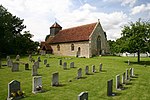Stoke College
1951 establishments in EnglandAC with 0 elementsBoarding schools in SuffolkEducational institutions established in 1951Grade II* listed buildings in Suffolk ... and 4 more
Grade II* listed educational buildingsIndependent schools in SuffolkPreparatory schools in SuffolkWorks of Edwin Lutyens in England
Stoke College in Stoke-by-Clare, near Haverhill, Suffolk, England, is a co-educational day school for children aged 11 to 18, with boarding for children aged 11 to 18. It is built on the site of a major medieval monastic college.
Excerpt from the Wikipedia article Stoke College (License: CC BY-SA 3.0, Authors).Stoke College
Ashen Lane, West Suffolk
Geographical coordinates (GPS) Address Phone number Website External links Nearby Places Show on map
Geographical coordinates (GPS)
| Latitude | Longitude |
|---|---|
| N 52.05954 ° | E 0.53867 ° |
Address
Stoke College
Ashen Lane
CO10 8JE West Suffolk
England, United Kingdom
Open on Google Maps









